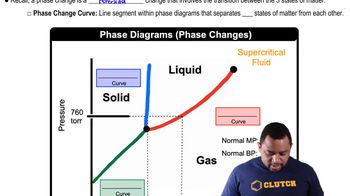The Kb for methylamine (CH3NH2) at 25 °C is given in Appendix D. (a) Write the chemical equation for the equilibrium that corresponds to Kb.
Ch.19 - Chemical Thermodynamics
Chapter 19, Problem 86b
The crystalline hydrate Cd(NO3)2⋅4 H2O(s) loses water when placed in a large, closed, dry vessel at room temperature: Cd(NO3)2⋅4 H2O(s) → Cd(NO3)2(s) + 4 H2O(g) This process is spontaneous and ΔH° is positive at room temperature. (b) If the hydrated compound is placed in a large, closed vessel that already contains a large amount of water vapor, does ΔS° change for this reaction at room temperature?
 Verified step by step guidance
Verified step by step guidance1
Identify the reaction: The decomposition of the hydrate Cd(NO_3)_2·4H_2O(s) into Cd(NO_3)_2(s) and 4 H_2O(g) is given.
Understand the spontaneity: The process is spontaneous, meaning the overall change in Gibbs free energy (ΔG°) is negative.
Consider the enthalpy change: ΔH° is positive, indicating the reaction is endothermic, absorbing heat from the surroundings.
Analyze the entropy change: Since the reaction involves the conversion of solid hydrate to solid and gaseous water, the entropy (ΔS°) increases due to the increase in disorder from solid to gas.
Evaluate the effect of water vapor: In a vessel with a large amount of water vapor, the increase in entropy (ΔS°) might be less pronounced because the system already has high entropy due to the existing water vapor.

Verified Solution
Video duration:
3mWas this helpful?
Key Concepts
Here are the essential concepts you must grasp in order to answer the question correctly.
Gibbs Free Energy
Gibbs Free Energy (G) is a thermodynamic potential that helps predict the spontaneity of a process at constant temperature and pressure. The change in Gibbs Free Energy (ΔG) is calculated using the equation ΔG = ΔH - TΔS, where ΔH is the change in enthalpy, T is the temperature in Kelvin, and ΔS is the change in entropy. A negative ΔG indicates a spontaneous process, while a positive ΔG suggests non-spontaneity.
Recommended video:
Guided course

Gibbs Free Energy of Reactions
Entropy (ΔS)
Entropy (S) is a measure of the disorder or randomness in a system. The change in entropy (ΔS) during a reaction indicates how the distribution of energy states changes. In the context of the given reaction, the formation of water vapor from a solid hydrate increases the disorder of the system, leading to a positive ΔS, which contributes to the spontaneity of the reaction.
Recommended video:
Guided course

Entropy in Thermodynamics
Phase Equilibrium
Phase equilibrium refers to the state in which the phases of a substance (solid, liquid, gas) coexist at equilibrium conditions. In the context of the question, when the hydrated compound is placed in a vessel with existing water vapor, the equilibrium between the solid and gaseous phases may shift. This can affect the overall entropy change (ΔS) of the system, as the presence of water vapor influences the potential for further evaporation or condensation.
Recommended video:
Guided course

Phase Changes in Diagrams
Related Practice
Textbook Question
610
views
Textbook Question
(a) Which of the thermodynamic quantities T, E, q, w, and S are state functions? (b) Which depend on the path taken from one state to another?
568
views
Textbook Question
(d) For a reversible isothermal process, write an expression for ΔE in terms of q and w and an expression for ΔS in terms of q and T.
688
views
Open Question
Indicate whether each of the following statements is true or false. If it is false, correct it. (a) The feasibility of manufacturing NH3 from N2 and H2 depends entirely on the value of ΔH for the process N2(g) + 3 H2(g) → 2 NH3(g). (e) Spontaneous processes are those that are exothermic and that lead to a higher degree of order in the system.
Textbook Question
For each of the following processes, indicate whether the signs of ΔS and ΔH are expected to be positive, negative, or about zero. (e) A piece of charcoal is combusted to form CO2(g) and H2O(g).
793
views
Textbook Question
The reaction 2 Mg(s) + O2(g) ⟶ 2 MgO(s) is highly spontaneous. A classmate calculates the entropy change for this reaction and obtains a large negative value for ΔS°. Did your classmate make a mistake in the calculation? Explain.
341
views
